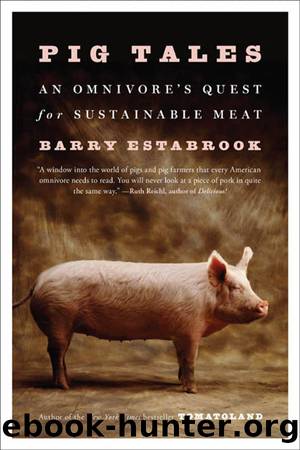Pig Tales: An Omnivore's Quest for Sustainable Meat by Barry Estabrook

Author:Barry Estabrook [Estabrook, Barry]
Language: eng
Format: epub
ISBN: 9780393248036
Google: owidBAAAQBAJ
Published: 2015-05-04T18:39:12+00:00
I HAD A FREE AFTERNOON before I had to head back to Copenhagen to catch my flight home, and Munck suggestedâalmost insistedâthat we take a tour of one of the slaughterhouses that processes his pigs. The managers there were expecting us, he said. The invitation took me aback. No large American meat-packer had ever invited me to tour one of its facilities, and my e-mail requests to do so had been flatly denied or gone unanswered.
We drove for a couple of hours, under the same wintry conditions and at the same speeds as we had on the way to Munckâs farm, finally arriving at a large modern factory. Agnete Poulsen greeted us in the lobby, handing me a business card identifying her as the corporate visitor manager for Danish Crown, a company 90 percent owned by a cooperative of hog producers. Inside, 1,750 employees kill and process 20,000 pigs a day, making it a huge facility even by US standards. We spent most of the afternoon there, watching as pigs walked off trucksâ185 pigs per truck, one truck every five minutesâand moved in groups of 16 through a maze of metal corrals until they reached a CO2 chamber. Anesthetized hogs tumbled out of the chamber, and one worker shackled their hind legs while another jabbed a sharp, hollow tube into their throats to bleed them to death. Upside-down on rails, the carcasses moved into a chamber filled with steam, which loosened their bristles. Mechanical brushes removed most of the hair, and any remaining bits got singed away in next chamber, a gas-fired inferno. After being rinsed under a row of what looked like shower heads and emerging white and spotless, the carcasses received ultrasounds to determine their leanness. Only then were the pigs ready to enter what Poulsen called the âclean endâ of the plant, where no outside dirt or bacteria was introduced.
There, six robots gutted the animals, each machine doing a single taskâcutting around the rectum, slicing open the belly, splitting the sternum, and hauling out the innards, which were deposited on plastic trays, one tray for each pig. Computer chips in the trays identified the individual pig that the organs had come from in case subsequent food-safety inspections revealed illness or infections. Humans separated the intestines from the other viscera, and loaded them for immediate shipment to a separate facility on the property to be cleaned of feces and made into casings. The hearts, lungs, livers, tracheas, and kidneys were destined for China and Vietnam, who use them in sausages. One man removed the pigsâ pinkish-white brains by hand and plopped them into a plastic tub. Within hours, they would be on an airplane to China.
Held together only by their snouts, the halved carcasses proceeded into a freezer where they stayed for ninety minutes, long enough for a thin, frozen shell to form on their outsides, but too little time for them to freeze solid, which would damage the quality of the meat. Then they traveled into a
Download
This site does not store any files on its server. We only index and link to content provided by other sites. Please contact the content providers to delete copyright contents if any and email us, we'll remove relevant links or contents immediately.
The Sprouting Book by Ann Wigmore(3531)
Better Homes and Gardens New Cookbook by Better Homes & Gardens(3509)
Trullo by Tim Siadatan(3365)
Super Food Family Classics by Jamie Oliver(3354)
Hedgerow by John Wright(3260)
Panini by Carlo Middione(3235)
Bread Revolution by Peter Reinhart(3067)
Sauces by James Peterson(3034)
Jam by Jam (epub)(3004)
Ottolenghi - The Cookbook by Yotam Ottolenghi(2857)
Oh She Glows Every Day by Angela Liddon(2707)
My Pantry by Alice Waters(2529)
Hot Sauce Nation by Denver Nicks(2439)
The Culinary Herbal by Susan Belsinger(2420)
Veg by Jamie Oliver(2399)
Wanderlust by Jeff Krasno(2216)
Meathooked by Marta Zaraska(2211)
The Art of Making Gelato by Morgan Morano(2203)
Basic Illustrated Edible and Medicinal Mushrooms by Jim Meuninck(2174)
